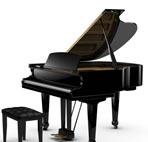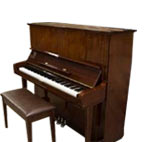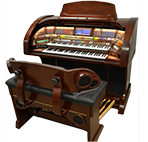 Dinu Lipatti
Dinu Lipatti
Romanian pianist and composer Dinu Lipatti (1917-1950) had a brief but exceptional career. Remembered mostly for his technical and interpretative skills, Lipatti was considered an exceptional performer of the works of Chopin, Mozart, and Bach among others. An inveterate perfectionist, Lipatti gave numerous well-received performances and, on a smaller scale, recorded music from his adolescent years up to a short time before his early death from cancer.
Showed Early Musical Talent
Constantin Lipatti, called “Dinu” from a diminutive of his baptismal name, was born on March 19, 1917, in Bucharest, Romania. His family was a musical one. His grandfather—for whom he was named— played the guitar and the flute; his father, Theodor, studied the violin in Bucharest and Paris before becoming a diplomat in Romania. Throughout his life, he collected rare violins. Lipatti’s mother, Anna Racoviceanu, was a talented pianist. Throughout his childhood, Lipatti was surrounded by music and perhaps unsurprisingly showed a particular talent for it. In their book Lipatti, Dragos Tanasescu and Grigore Bargauanu claimed that “at six months [Lipatti] was clapping time to the melodies and Czardes dances…he became highly excited by the sound of a hurdy-gurdy being played by an old man passing in the street. By the age of two he could imitate any sound from the clinking of glass to the horn of an automobile.”
Because Theodor Lipatti was concerned that his young son might damage one of his old and valuable violins, the family instead encouraged Dinu Lipatti to take up playing the piano. By the time of Lipatti’s christening at the age of four, he was able to play one of Mozart’s Minuets and Bach’s Prelude in C. Georges Enusco, perhaps Romania’s foremost musician of the twentieth century, was Lipatti’s godfather. As a child, Lipatti studied first with Mikhail Jora; in 1928, he entered the Royal Academy of Music and Drama in Bucharest to study under Floria Musicescu. These two teachers were greatly influential in Lipatti’s development, both as a musician and as a young man.
Continued Studies in Paris
Lipatti was a dedicated, self-disciplined student. While still in school, he made his solo debut at Bucharest’s Opera House, and graduated in 1932 having received the prestigious Paul Ciuntu Prize. In 1933, he won second prize in the Georges Enusco Composition contest for his “Sonatina for Violin and Piano” and second prize at the Vienna International Piano Competition. Alfred Cortot, a renowned Swiss pianist, quit the jury in Vienna because he believed Lipatti was unfairly denied the First Prize. Cortot soon invited Lipatti to study with him in Paris, where he arrived in August 1934. There, Lipatti studied piano under Cortot as well as pianist Yvonne Lefebure and composition under famed instructor Paul Dukas. After the death of Dukas in 1935, he went on to study with Nadia Boulanger, whom, according to Lipatti’s Grove Music Online biography, he called his “musical guide and spiritual mother.” During this time, Lipatti also developed friendships with several rising French composers and musicians, such as Pierre-Octave Ferroud.
Although Lipatti’s instructors and peers considered him a fine musician and composer, Lipatti himself suffered from self-doubt. Tanasescu and Bargauanu wrote that “the search for perfection continued to dominate Dinu’s life, and his torments while finding himself as a composer became a leit-motif in every letter.” Even after highly successful performances such as his 1934 recital of Liszt’s First Concerto in E flat with the orchestra of the Ecole Normale de Musique, conducted by Cortot, Lipatti focused only on Cortot’s suggestions for improvement, rather than his strong praise for the overall performance. The following year, Lipatti played the Paris debut of Enesco’s Piano Sonata in F sharp minor to much acclaim. Also in 1935, Lipatti gave his first Paris recital, playing works by Bach-Busoni and Johannes Brahms. The skill he displayed in this debut was such that the Director of the Ecole Normale invited him to sit with faculty members of the school to judge candidates for its Diploma of Virtuosity. In October of that year, Lipatti performed two concerts in Switzerland, one for radio broadcast and the other at Montreuz with the well-respected Manhattan Quartet.
The year 1936 marked other notable accomplishments for Lipatti. In January, his symphonic suite Satrarii (The Gypsies) was performed for the first time at a concert of Romanian music in Bucharest. Lipatti’s Sonatina in E minor for Violin and Piano made its debut in March as part of another concert dedicated to Romanian music, this time in Paris. Lipatti remained in Paris, continuing his studies and composing and performing music, until summer 1936 when he returned to his native Romania. There, he first gave a recital with Enesco; in November, he performed as a soloist with the Bucharest Philharmonic in one of Mozart’s Concertos.
In 1937, Lipatti returned to Paris to continue his studies with Cortot and Boulanger. He often played with Boulanger and began receiving offers to record music. At first, he refused these offers, but then changed his mind, turning his selfdiscipline and driving need for perfection to his recording sessions. According to Grove Music Online, Lipatti’s “recorded legacy is small but beyond price.” During the summer of 1937, Lipatti participated in the festival of Romanian classical that was organized as part of the Exposition Internationale de Paris. He returned to Romania in the fall for a series of concerts, then returned briefly to Paris to complete a recording of Brahms with Boulanger before traveling to Italy in early 1938 for a series of concerts. Back in Paris, he gave a recital featuring the debuts of many works by Romanian composers, including Enesco and his former teacher Jora, in February. At about this time, Lipatti began studying conducting at the Ecole Normale under Diran Alexanian and Charles Munch. However, he soon determined that he could not effectively focus on the three fields of piano, composition, and conducting, and so gave up the latter.
Returned to Romania
In March 1939, Lipatti gave a significant recital at the Salle Chopin-Pleyal in Paris. This performance marked the first time critics evaluated Lipatti’s work as that of an adult master, and not that of a talented youth. However, the rising tensions that would lead to World War II drove Lipatti to return to Romania, which remained his home for the duration of the conflict. He quickly became active in the Romanian musical scene, performing concerts and, in April 1940, acting as conductor for the only time in his career during a radio concert. In 1941, Lipatti toured with the Bucharest Philharmonic as a soloist, visiting major eastern European cities including Prague, Berlin, and Munich. After his return, he spent much of his time composing, giving occasional performances for special events. Around the close of the year, he again traveled with the Bucharest Philharmonic, visiting Austria, Bulgaria, and Slovakia. In early 1942, he gave several recitals with George Enesco; that March, a concert was given featuring his and fellow Romanian composer Silvestri’s compositions. Later that year, he returned to Berlin, Vienna, and Rome to perform.
In 1943, Lipatti recorded one of his compositions, Concertino in Classical Style, in Berlin. Shortly afterwards, he began making plans to tour Scandinavia. Despite the difficulties of war, he gave a series of performances primarily in Sweden in the fall of 1943. He then traveled to Geneva, Switzerland, for a recital and wound up settling in the city with the intention of working with Swiss pianist, Edwin Fischer. Toward the end of the year, he fell so ill that he could not get out of bed. Angered and concerned by the mysterious sickness, Lipatti was forced to cancel performances and found himself seeking a way to remain in Geneva. He was soon made a professor at the Geneva Conservatory. About a year later, Lipatti found himself continuing to battle his mysterious illness; he believed that a cure was in sight when X-ray therapy briefly lessened his symptoms. Despite his poor health, Lipatti continued to perform not only in Switzerland, but also in France, Belgium, and Italy.
Diagnosed with Cancer
Around the beginning of 1946, Lipatti experienced a brief period of good health. However, this soon deteriorated and Lipatti embarked on a course of biopsies and x-rays and altered his playing style to put less stress on his painfully swollen arms. Tanasesco and Bargauanu noted that “when playing the piano his movements became more deliberate and economical … no one imagined that the beautiful tones, precision and subtleties of his interpretations were the result of such great effort.” Increasingly, Lipatti found some works too exhausting to perform and was forced to cancel a planned tour of the United States. Despite his illness, he was able to travel to Belgium to give some performances. Also in 1946, he signed a contract with Columbia Records to make a series of recordings; he recorded some pieces at his home in Geneva.
Against the advice of his doctors, Lipatti continued touring throughout Europe in 1947. These activities were halted somewhat due a new diagnosis of malignant lymphogranulomatosis, a generic description of the cancer of the lymph nodes now referred to as Hodgkin’s disease. After a brief period of rest, Lipatti gave concerts in Italy and Switzerland in the spring; that fall, he performed in England, Switzerland, and the Netherlands. Around the end of 1947, Lipatti underwent radiation treatment for his cancer and suspended musical work. By spring, he was again touring around Europe but was unable to accept offers to perform in such far-flung destinations as Egypt and South America.
During the summer of 1948, Lipatti’s condition worsened and he began treatments in a hospital in Geneva. The following year, Lipatti married his longtime companion, pianist and teacher Madeleine Cantacuzene. His health continued to worsen, and in 1949, he suffered from complications arising from the aggressive treatments.
Death and Legacy
A brief improvement of his condition, in 1950, permitted Lipatti to play some concerts in Switzerland and to make recordings for Columbia; ultimately, more than half the planned recordings were completed. On September 19 of that year, Lipatti gave his final concert at Besanc¸on in France; Grove Music Online stated that “he gave incomparable performances” at this concert while Dragos Tanasesco, writing in Dinu Lipatti Remembered, said that it “might be compared to a sacrifice offered by the performer on the altar of art.” Lipatti died from cancer at his home on December 2, 1950, at the age of 33. He was buried at Chêne-Bourg, Switzerland.
Lipatti’s career could be characterized as short but brilliant. His technical and interpretative skills, particularly while playing the works of composers such as Frédéric Chopin and Johan Sebastian Bach, were considered topnotch by his contemporaries. His composition abilities were also strong, although a relatively small portion of his 41 works are readily available today. Music lovers still admire Lipatti and this is evident in the 2004 creation of the Lipatti-Haskil Foundation, dedicated to the preservation of the works of Lipatti and fellow Romanian pianist Clara Haskil. It seems unquestionable that Lipatti’s great talent would have continued to flourish if not for his unfortunate early death.










